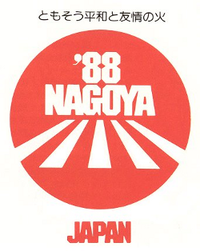
The Chūbu region, Central region, or Central Japan is a region in the middle of Honshū, Japan's main island. In a wide, classical definition, it encompasses nine prefectures (ken): Aichi, Fukui, Gifu, Ishikawa, Nagano, Niigata, Shizuoka, Toyama, and Yamanashi.
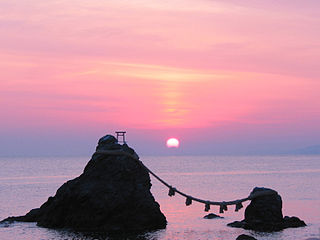
Mie Prefecture is a prefecture of Japan located in the Kansai region of Honshu. Mie Prefecture has a population of 1,781,948 and has a geographic area of 5,774 square kilometers (2,229 sq mi). Mie Prefecture is bordered by Gifu Prefecture to the north, Shiga Prefecture and Kyoto Prefecture to the northwest, Nara Prefecture to the west, Wakayama Prefecture to the southwest, and Aichi Prefecture to the east.

The Tōkai region is a subregion of the Chūbu region and Kansai region in Japan that runs along the Pacific Ocean. The name comes from the Tōkaidō, one of the Edo Five Routes. Because Tōkai is a sub-region and is not officially classified, there is some disagreement about where exactly the region begins and ends, however Japanese maps widely conclude that the region includes Shizuoka, Aichi, Gifu and Mie prefectures.

Okazaki is a city located in Aichi Prefecture, Japan. As of 1 October 2019, the city had an estimated population of 386,999 in 164,087 households, and a population density of 999 persons per km². The total area of the city was 387.20 km2 (149.50 sq mi).

Ichinomiya is a city located in Aichi Prefecture, Japan. The city is sometimes called Owarichinomiya to avoid confusion with other municipalities of the same name, including Ichinomiya and Ichinomiya in Chiba Prefecture. As of 1 October 2019, the city had an estimated population of 379,654 in 161,434 households, and a population density of 3,336 persons per km2. The total area of the city was 113.82 square kilometres (43.95 sq mi).

Toyokawa is a city in the eastern part of Aichi Prefecture, Japan. As of 1 October 2019, the city had an estimated population of 183,930 in 72,949 households, and a population density of 1,141 persons per km2. The total area of the city is 161.14 square kilometres (62.22 sq mi). Toyokawa, famous for its Toyokawa Inari temple, has a good balance of industry, commerce, agriculture and forestry, and is situated in an area rich in history, traditions, and culture.

Toyota, formerly known as Koromo, is a city in Aichi Prefecture, Japan. As of 1 October 2019, the city had an estimated population of 426,162 and a population density of 464 people per km2. The total area was 918.32 square kilometres (354.57 sq mi). It is located about 50 minutes from Nagoya by way of the Meitetsu Toyota Line.

Aichi Prefecture is a prefecture of Japan located in the Chūbu region of Honshū. Aichi Prefecture has a population of 7,552,873 and a geographic area of 5,172.92 square kilometres (1,997.28 sq mi) with a population density of 1,460 inhabitants per square kilometre (3,800/sq mi). Aichi Prefecture borders Mie Prefecture to the west, Gifu Prefecture and Nagano Prefecture to the north, and Shizuoka Prefecture to the east.
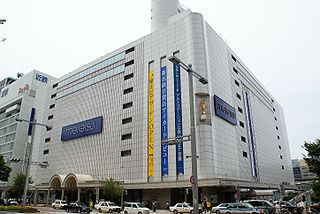
Nagoya Railroad Co., Ltd., referred to as Meitetsu (名鉄), is a private railway company operating around Aichi Prefecture and Gifu Prefecture of Japan. TYO: 9048
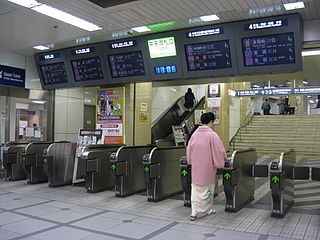
Meitetsu Nagoya Station is the principal station of the Nagoya Railroad (Meitetsu) system in Nagoya, Japan. Most trains of Meitetsu's major lines operate through this station. The station is also a gateway to the Chūbu Centrair International Airport, which is connected with the station by the Rapid Express service started on January 29, 2005.

Chūkyō, or the Chūkyō region, is a major metropolitan area in Japan that is centered on the city of Nagoya in Aichi Prefecture. The area makes up the most urbanized part of the Tōkai region. The population of 10,110,000 over an area of 7,072 square kilometers. Nevertheless, like most of Japan's major metro areas, the core of it lies on a fertile alluvial plain, in this case the Nōbi Plain.
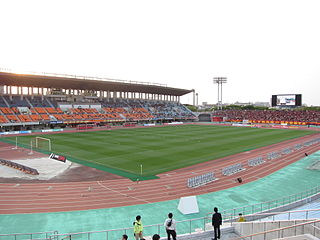
Paloma Mizuho Stadium was a multi-purpose stadium in Nagoya, Japan.

The Nagoya Municipal Subway is a rapid transit system serving Nagoya, the capital of Aichi Prefecture in Japan. It consists of six lines that cover 93.3 kilometers (58.0 mi) of route and serve 87 stations. Approximately 90% of the subway's total track length is underground.

Osaka 2008 was one of the five short-listed bids for the 2008 Games, presented by the city of Osaka, Japan. The city won its right to represent Japan over Yokohama when chosen by the Japanese Olympic Committee.

The Tōkai–Tōsan dialect is a group of the transitional Japanese dialects spoken in the southern and eastern Chūbu region. The dialects spoken in the northwest Chubu region are classified as the Hokuriku dialect of Western Japanese. The Tokai–Tosan dialect has three sub-groups: Gifu–Aichi, Echigo, and Nagano–Yamanashi–Shizuoka. These are transitional between Western and Eastern Japanese; which branch of the family they fall in depends on which isoglosses are taken as definitive.
The Mikawa dialect is a Japanese dialect spoken in eastern half of Aichi Prefecture, former Mikawa Province. It is subdivided into western variety centered Okazaki and eastern variety centered Toyohashi. The Mikawa dialect is classified into the Gifu-Aichi group of the Tokai-Tosan dialect with the Nagoya dialect spoken in western half of Aichi Prefecture, however the Mikawa dialect also closes to dialects spoken in western Shizuoka Prefecture and southern Nagano Prefecture.
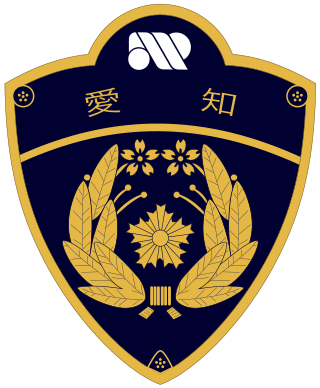
The Aichi Prefectural Police is the prefectural police force responsible, under the control of the Aichi Prefectural Public Safety Commission, for policing Aichi Prefecture.
